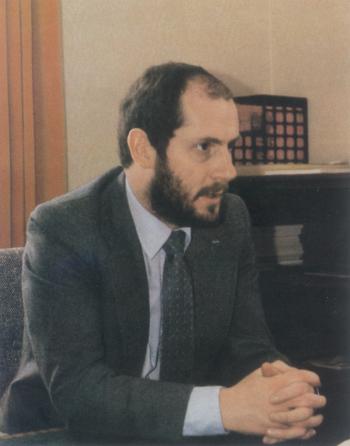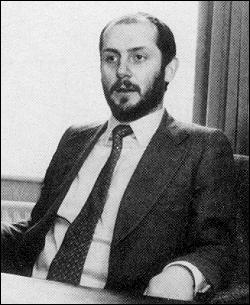| inside sinclair |

Elspeth Joiner talks to Nigel Searle, new chief of Sinclair's Computer Division
THE launch of the Spectrum is only a part of the development plans of the Sinclair Research computer division in the coming year. The company also intends to produce another small computer, market a full range of peripherals and software for all its computers, and expand overseas and into the educational market.
The man behind the ambitious expansion plans is the newly-appointed head of the division, Nigel Searle.
"I expect we will launch at least one new computer which will not replace the ZX-81, but which will sell alongside the ZX-81 and be the beginning of a range of computers", he said.
"By the end of the year they will be fully-supported in terms of peripherals and software. We have already developed a mass storage device which is of our own design and that will be announced later this year".
He added that in future Sinclair intends to launch new computers with a full range of software.
Of the educational market, Searle said: "Many schools have a ZX-81, but the price of them is such that many schools ought to have 20 or 30 of them. We hope to penetrate that market in the U.K. and elsewhere".
This ties with his plans for overseas growth. The company is in the middle of searching for foreign distributors.
"We expect our overseas sales to increase substantially", he said.
Searle became head of the computer division four months ago and has a long association with Clive Sinclair. He first joined him in the Sinclair Radionics company 10 years ago designing pocket calculators. He then moved to the U.S. first in California and later in New York, where he was responsible for promoting the company's calculators and watches.
He stayed with the company until 1977 when he left. "The calculator business was not doing too well and also it was not really the same company once the National Enterprise Board was involved", he said.
Two years later Clive Sinclair formed Sinclair Research, launched the ZX-80 and Searle rejoined him. He ran the U.S. office in Boston, concentrating on selling the ZX-80 and 81 until taking-up his new job.
Software is an area in which Searle is particularly interested. The company has begun a software development project which should build the library to 200 programs by the end of the year.
"They will be available only through W H Smith, 26 to start with, which is just the tip of the iceberg, covering games, education and some business. It is an area we have neglected in the past but we have spent time getting together a wide range of software for the ZX-81".
Searle has been involved closely with the launch of the Spectrum and he has decided to continue Sinclair's unusual marketing strategy of concentrating on mail order.
"With minor variations we are launching our new products the same way we always have done", he said, but added, that "there are no plans at present for putting the new machine into W H Smith, which is Sinclair's only retailer".
He said the reason was that "not many others are selling so many computers as we are. We have sold far more computers by mail order than anyone who has sold through stores".
He added that the original idea behind the mail order decision was that when Sinclair first went into the computer market there was no obvious retail outlet for a personal computer.
"It does not occur to me, or anybody else, that Boots, Currys, Rumbelows, would sell a computer.
"It also makes good sense financially to sell through mail order. We do not have to give a discount to retailers which you normally have to do".
The promotion of a new product through retail distribution can cost so much that the price of the product has to be raised by 50 percent.
Heavy advertising is still essential and Searle again adopts an unusual policy by not having a pre-determined budget.
"We are willing to spend as much on advertising as will produce a profitable number of sales", he explained. Last year the cost was slightly more than £5 and in 1982 it looks as if it will be more than £10 million.
Where that is spent depends on the product with advertising in the technical press computer journals, particularly the magazines, and the Sunday magazines.

"So far we have had products which have been of interest to both the specialist computer market and the general enthusiast market but we might well have products in the future which would be of interest only to your serious computer user".
For the Spectrum, Searle is concerned not only with selling the machine but also with persuading people that is it better than rival products. "We would not introduce a computer unless it was significantly different from our existing one. It will appeal to a much wider market and we will be trying to persuade people to buy it in preference to other products," he said.
His return to Britain has made life much more hectic than it was when he was in Boston selling the two ZX computers.
"So far working here has been a bit like jumping on a train which is passing at about 60mph. It seems as though there are many things to be done".
Timex obviously has a fair amount of confidence in the product it is assembling for Sinclair, demonstrated by its use of the ZX-81 to test the printed circuit board of the Nimslo 3D camera, assembled by Timex and soon to be marketed in the U.S.
Sinclair believes that such confidence is well justified, pointing to what it considers to be a low percentage of returned equipment. The return figure on the ZX-81 is 2.4 percent, though the percentage return on kits is higher, at around 13 percent.
Chatten claimed that the higher figure of kit returns is due more to poor component insertion and bad soldering than to component failure but stressed that if any component failure is found, the £10 which kit customers have to pay for a ZX-81 to be serviced is returned.
He admitted that of the 2.4 percent returns of supplied ZX-81s, around one percent of failure is due to power supply faults, an area in which Chatten believes there could well be improvement. In fact, it is Clive Sinclair's stated aim for a return percentage of one percent overall and it is partly to that end that he recently appointed a quality assurance manager, David Fuller.
While an aim for continued improvement in machine reliability is a necessary part of successful business practice, the gamble of engaging a company with little experience in electronic assembly seems to be paying-off. Chatten commented:
"There is some room for improvement in the assembly process - perhaps greater use of automated production lines - but on the whole we are very pleased with Timex work".